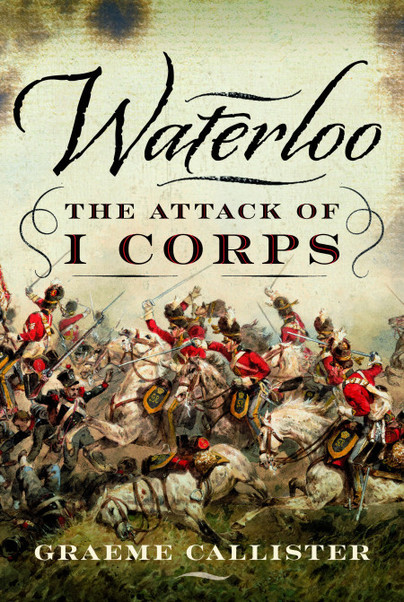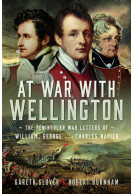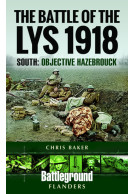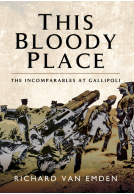Waterloo: The Attack of I Corps (Hardback)
Imprint: Pen & Sword Military
Pages: 256
Illustrations: 12 mono illustrations
ISBN: 9781399045421
Published: 23rd September 2024
(click here for international delivery rates)
Need a currency converter? Check XE.com for live rates
This book provides a detailed analysis of the attack of the Comte d’Erlon’s French I Corps, and the subsequent allied counterattack, at the Battle of Waterloo. This assault by 20,000 men and eighty guns in the early afternoon of 18 June 1815 came as close as any to winning the battle for Napoleon. It was eventually repulsed – just – by two stretched Allied infantry divisions and two brigades of cavalry and was, in the words of the Duke of Wellington himself, “one of the most serious attacks made by the enemy.” Until now, there has been surprisingly little in-depth analysis of this crucial moment in the battle – something that this book seeks to remedy.
Graeme Callister combines a detailed narrative with a thorough analysis of how the event unfolded. All aspects of the attack are covered; from the grand tactics to the human experience of being in the firing lines, considering the soldiers’ experience, morale, leadership, condition and cohesion. Using rarely before analysed material from the French regimental registers, it examines the service records of individuals involved in the action, alongside the first-hand accounts and reminiscences of those who left them.
The book begins with an assessment of the background of each of the forces: their composition, command structures, and the condition of their men. It then discusses how they found themselves to be in their positions on the battlefield, exploring the grand tactics, terrain, and wider strategic situation. The main part of the analysis focuses on the attack itself, looking at the formations and direction of the attacking forces (the four divisions of Quiot, Donzelot, Marcognet, and Durutte, plus the grand battery and supporting cuirassier brigade) and the tactical approach of the men set to meet them.
Based on a wide range of primary sources, including those in French, English, Dutch and German, this book offers fresh perspectives on a crucial part of the Waterloo story, and helps us to understand why men advanced or stood, fought or ran, and lived or died amidst the maelstrom of battle.
This is not just another book about the Battle of Waterloo: the author, a Senior Lecturer in History and War Studies at York St John University, presents a detailed analysis of the attack of Comte D’Erlon’s I Corps, described as ‘one of the most serious attacks made by the enemy’ in the Duke of Wellington’s Waterloo Dispatch, that has - until now - not had a single book entirely devoted to it, unlike the defence of Hougoumont and La Haye Sainte, or the final attack by the French Imperial Guard. Even Captain William Siborne’s model has been the subject of two books!
Miniature Wargames
In Chapter 1, Openings, the author explains that his focus will require analysis of the build-up of the two opposing armies and of their movements in the campaign before the battle, because ‘assessing the formation of the army, the previous service of the troops, and how they were equipped, nourished, and led, is vital to judging the cohesion, character, and confidence of the men who marched into battle.’ This he does in the following two chapters, considering only the troops of D’Erlon’s I Corps and the various infantry and cavalry units – British, Hanoverian and Netherlands – that would oppose them.
Chapter 4 narrates the opening movements of the campaign, and Chapter 5 describes the engagement at Quatre Bras, a significant experience for many of the Allied troops who would later fight D’Erlon’s I Corps, but not for the latter, which was wasted in marching towards Ligny to support Napoleon there, only to be recalled by Marshal Ney.
The next chapter deals with the withdrawal to Mont Saint Jean and the French pursuit on 17th June, and describes how both armies encamped that night in the rain.
A Tale of Two Ridges examines how the men prepared for battle on the morning of the 18th June, considering their food – or lack of it – the preparation of their weapons and their morale, before describing the deployment of the Allied forces on that part of the field where I Corps would attack.
Next, Command and Confusion first describes how French infantrymen deployed for battle; then considers Napoleon’s battle plan and the orders given to Comte D’Erlon; discusses the alternative ideas about the siting of the grand battery that would provide artillery preparation for I Corps’ attack; and explains the formations adopted by the divisions of I Corps and their inherent drawbacks.
The remaining five chapters offer a detailed narrative, using many eyewitness accounts, of the advance of I Corps, its initial success in fighting Allied troops on the ridge, its repulse and rout by the cavalry, the counter-attack by French cavalry; the casualties suffered by both sides and the significance of the defeat of I Corps. The author concludes, ‘The actions of Picton and Perponcher’s men, and of the troopers of Somerset, Ponsonby, Vandeleur and de Ghigny, did not win Waterloo, but they certainly prevented it from being lost.’
Five full-page maps show the Positions Prior to Invasion; an Overview of Battle, 18 June 11:30 am; D’Erlon’s Attack; Picton’s Counter-attack, and the British Cavalry Charge, all reproduced from Gareth Glover’s Waterloo: Myth and Reality (Barnsley, 2021).
Eight pages of monochrome plates contain reproductions of portraits of D’Erlon, Ney, Picton, Uxbridge, and the Prince of Orange; a print of La Haye Sainte after the battle; The Battle of Waterloo painted by Jan Willem Pieneman (1824); The Prince of Orange with the Belgian Troops Attacking the French by Charles Turner Warren (1818); Ces Terribles Chevaux Gris as Napoleon Designated the Royal Scots Greys…at Waterloo by Orlando Norie (1880), also reproduced in colour on the dustjacket ; modern photographs of the site of I Corps’ attack; the battlefield of Waterloo, looking eastwards from the Lion Mound; the Allied centre-left from the French ridgeline; La Haye Sainte today; and the sunken lane leading from Durutte’s position towards Papelotte.
There is also one diagram: Cross-section of the battlefield, looking westwards c.100m from the highway. The caption warns readers that ‘the two axes of the chart have different scales, exaggerating the steepness of the terrain.’ Why do that, then? It does not help readers appreciate the terrain, but risks giving a completely false impression of it.
Thirty pages of endnotes, a twelve-page bibliography and a seventeen-page index conclude the book.
This book is a significant addition to the already extensive literature on the Battle of Waterloo, describing the first major French attack and its repulse in much greater detail than is to be found in histories of the entire battle and offering a thoughtful, and convincing, analysis of the reasons for its failure. Some of the points raised, such as the manner in which men were arranged by height in French infantry battalions, are equally relevant to other engagements, so the book also adds to our general understanding of the French army of that era.
After reading it, wargamers may well be inspired to devise scenarios for tabletop recreations of just this part of the battle, as it contains nearly all the information necessary. It might also offer a useful scenario for testing wargame rules to discover whether or not they can portray the nature of the fighting in this part of the battlefield convincingly.
I am very glad to add this book to my Waterloo collection and wholeheartedly recommend it to all readers with an interest in the battle.
About Dr Graeme Callister
Dr Graeme Callister is a Senior Lecturer in History and War Studies at York St John University, with extensive experience of researching and teaching the history of warfare. He is also a Fellow of the Royal Historical Society. He received his PhD in History from the University of York, and his first book, War, Public Opinion and Policy, was published in 2017. His most recent work has been on the British campaign in the Low Countries in 1793-5 and on conscription in Napoleonic France.
















